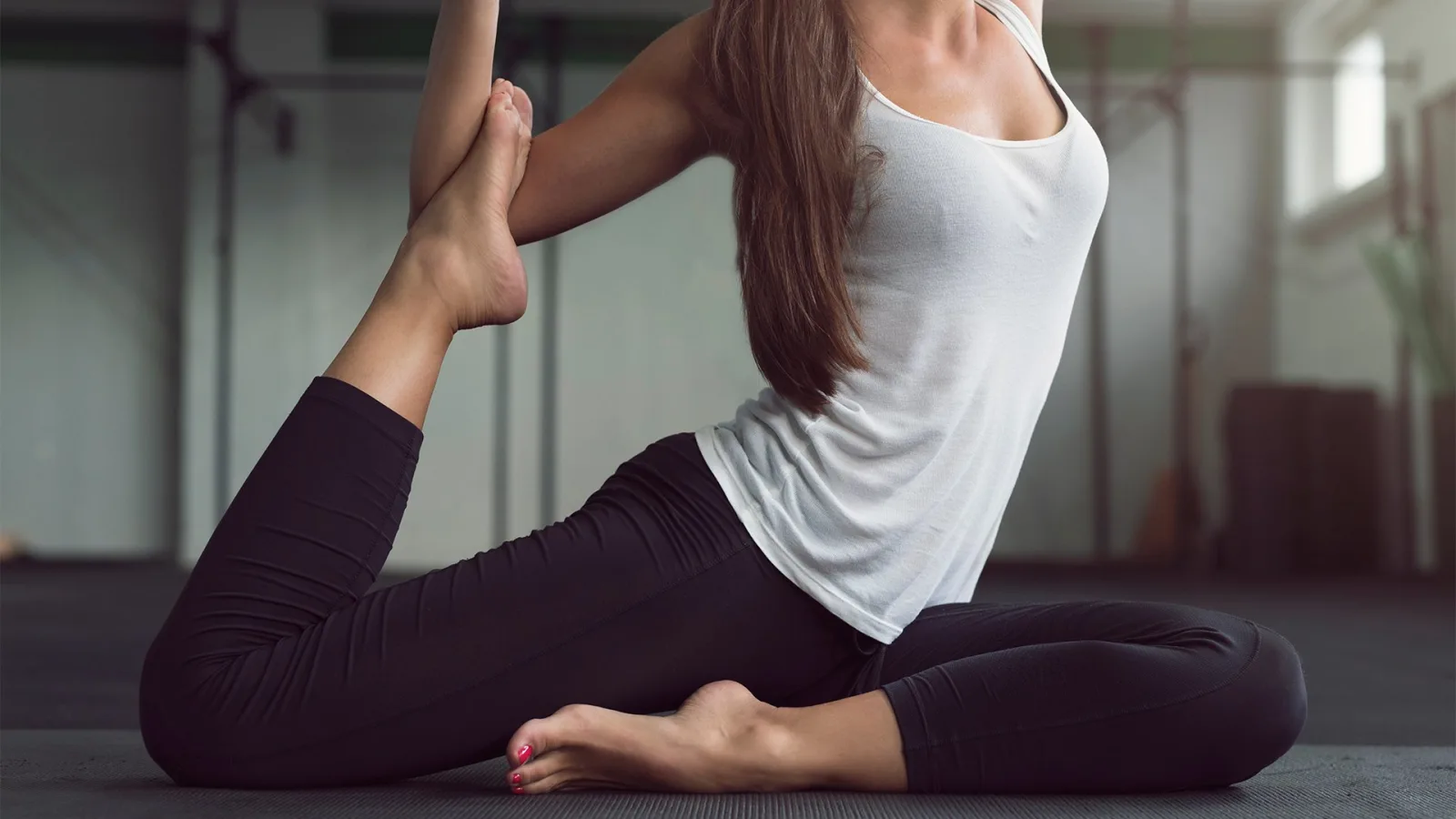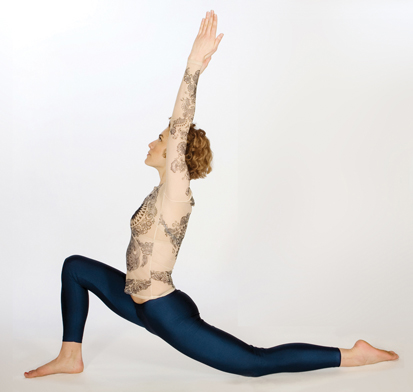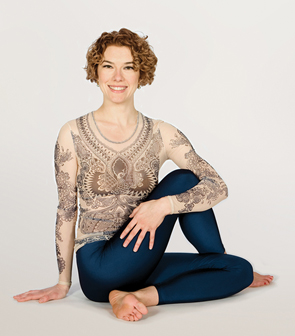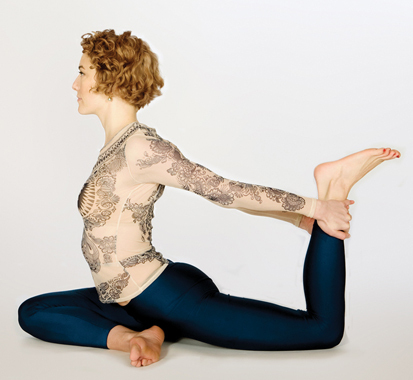
Kapotasana: Pigeon Pose
In Sanskrit, kapota means “pigeon,” and asana means “pose.” So kapotasana, literally, means a posture mimicking a pigeon. You’ll get a sense of this if you sit with one leg bent and the other leg stretched straight out behind you. With your hands on the floor for balance, lift your spine upright and widen your chest. Add a little imagination, and you will experience yourself as a proud pigeon. Is this what yogasana is all about—a journey from being human to becoming a pigeon?
Although people tend to think of kapotasana as merely a bird-shaped asana, it is actually named after a great master, Kapota, whose yogic accomplishments are documented in scriptures such as the Mahabharata and the Kalika Purana.
Not exactly! Although people tend to think of kapotasana as merely a bird-shaped asana, it is actually named after a great master, Kapota, whose yogic accomplishments are documented in scriptures such as the Mahabharata and the Kalika Purana. In power, vigor, strength, vitality, and agility, Kapota had no match. When he walked, it seemed his soul was several feet ahead of his body—he moved as though not touching the ground. Thus people called him the son of Garuda, the mighty bird serving as a vehicle for Lord Vishnu. Beauty and virility so exuded from his body that he commanded Chitrangada, the daughter of the celestial nymph, Urvashi, to marry him. His intuitive wisdom was so clear and perfect that even the sons of Shiva—Bhairava and Vetal— sought guidance from him. Even today he is believed to be living, visiting the famous cave shrine of Amarnath in Kashmir once a year. If practiced properly, kapotasana can take us to the same level of accomplishment as the sage Kapota.
Building Kapotasana
One of 84 classic asanas, kapotasana is a challenging backbend that benefits from proper preparation. We’ll start with hanumanasana, an opening for the groin, thigh, and hip which is similar to (but less intense than) the demands of kapotasana.
Modified Lunge (Hanumanasana)

From the hands and knees of downward dog, step the right foot forward between the hands, keeping the knee directly above the ankle. With the toes turned under, straighten and stretch the left leg back until your weight and the pelvis are centered between the front and back legs. Turn the top of the left foot to the floor and lower the knee to the floor. Adjust the right leg so the knee is over the middle toes and directly above the ankle, and drop the pelvis and right thigh toward the floor. Then stack the torso over the pelvis, lifting the chest directly over the upright pelvis. Inhale the arms out to the side and up alongside the ears. Continue lifting the chest and arms up and back as you anchor down through the pelvis. Stretch up through the arms and torso in reaction to the downward drop of the pelvis. Breathe into the expanded inner space of the chest, and down into the pelvis and legs. Feel the back thigh and groin lengthen and the lower belly move inward to support the lift of the lumbar spine. Don’t lean forward! Hold for at least six breaths, then with an exhalation, lower the arms to the floor and reverse the leg position to repeat on the other side.
Seated Spinal Twist (Matsyendrasana)

A seated spinal twist will stretch the muscles of the waist, lower back, and pelvis, and allow you to work more deeply in the backbending aspect of kapotasana. For matsyendrasana, sit with the left heel near the right hip. Step the right foot over the left leg and plant it firmly in the floor near the outer edge of the thigh. Use the hands on the floor on either side of the pelvis to sit up straight, lifting the lumbar spine up as you press the sit bones down. Exhale and use the deep lower abdominal muscles to rotate to the right. Inhale and again lift the spine, checking your neutral alignment and staying full in the back of the waist without collapsing. Draw the shoulder blades down and keep the shoulders level as you lift the sternum. Bring the left arm to the right knee, either embracing the knee or bracing the arm on the outside of the knee. Breathe and bring balance and fullness to both sides of the torso. Keep the neck long and turn the chin over the right shoulder. When you are ready to release, exhale and turn the head and then the chest back to neutral. Repeat to the other side.
A Gentle Backbend (Bhujangasana)

A gentle backbend completes the preparation for kapotasana. Lie face down with your hands on the floor, near the side of the ribs, and the feet a few inches apart. Press the top of the feet and the pubic bone into the floor, draw the shoulder blades down the back, and inhale to lift the chest. Use the arms to support the lift of the chest—but the lift should come from the muscles of the back. Breathe and feel the lower ribs expanding, the chest opening, and the spine lengthening. Avoid throwing the head back and pinching the back of the neck. Focus on broadening the lower ribs, chest, and collarbones. To come down, exhale and first lower the lower ribs, then the sternum, and finally the head. Repeat and come up a little higher this time, pressing down into the floor through the hands to help press the chest forward and open. Keep the pelvis firmly on the floor and continue drawing the shoulder blades down to expand the front of the chest.
Pigeon Pose (Kapotasana)

Kapotasana is easily adapted for all levels of accomplishment. To begin, you may need just to work with the legs and pelvis. From downward dog or from the hands and knees, slip the right knee forward between the hands, and bring the foot out slightly near the left hip. Lower the pelvis and stretch the left leg straight out behind, lowering the knee to the floor. If your pelvis is not resting comfortably on the floor, you may need a folded blanket or a bolster to support the right hip. Turn the toes under to draw the left leg back and further open the groin and thigh. Then flatten the foot to the floor and sink the pelvis as you walk the hands back beside the pelvis. Draw the tailbone down to align the pelvis vertically and lift up through the torso, centering the pelvis between the legs and centering the crown of the head over the pelvic floor. Draw the shoulder blades down and broaden the collarbones as you did in the cobra pose. Don't forget to breathe! This may be as far as you go in the pose. If so, repeat on the other side.
Or, to continue and deepen the backbend, bend the left knee and reach the foot toward the ceiling, keeping the thigh tracking straight back. Bring one or both hands to the ankle or foot. Hold the ankle or the foot, but in either case, press into the hand(s) as you draw the foot toward the body. This activates the thigh and foot, and opens the chest, shoulders, and upper back. Be careful to keep the pelvis and shoulders level and facing forward, and the thigh and shin square. Think about the chest opening and the toes and the crown of the head reaching toward each other behind the heart. Repeat on the other side.
Finally, for the fullest expression of kapotasana, grasp the foot from the outside edge and rotate the elbow out and up as you draw the foot toward the head. If you are well balanced, bring the other hand straight out in front and overhead to also grasp the foot. This version of the pose requires significant flexibility in the shoulders and upper spine, as well as in the thigh and pelvis. Repeat on the other side. Then finish with a gentle forward bend like the child’s pose to release any strain in the back.
The Deeper Dimensions of Kapotasana
In its full expression, kapotasana impacts all the organs and glands between the thighs and the brain—the testes, ovaries, uterus, bladder, kidneys, spleen, pancreas, heart, liver, lungs, colon, the en-tire gastrointestinal tract, and the thymus, thyroid, pineal and pituitary glands. Each of these plays a crucial role in our overall health and well-being. And because they are regulated by the autonomic nervous system, they function independently of our conscious control. In the language of yoga, this is the region of the body enveloped in darkness and governed by survival instincts. We have no conscious awareness of what is going on in these organs, and yet for the most part, they function intelligently and harmoniously. Let us take the example of the kidneys.
Recently, I asked a medical student how the kidneys know what to filter out of the blood, and what to leave. The young man responded, “The kidneys are not just simple filters. In fact, if I were even half as intelligent as my kidneys, I could complete my medical training at the snap of my fingers!” The kidneys, he continued, not only detect the concentration of salt in the blood; they are also able to measure precisely the presence of hormones, enzymes, and micronutrients, and act accordingly to maintain balance and good health. It is only when they get confused that problems begin.
The confusion begins when we develop unhealthy lifestyle habits that disrupt communication and cooperation between the organs and the glands.
The confusion begins when we develop unhealthy lifestyle habits that disrupt communication and cooperation between the organs and the glands. For example, if the liver or the colon is not functioning properly due to poor diet and no exercise, the kidneys must struggle to manage a toxic situation for which they are not designed.
Kapotasana opens the deep abdomen, pulls the energy from the thighs, and concentrates it at the navel center.
So is the case with all the organs in the abdomen. Kapotasana energetically connects these organs, creating an environment where they communicate and support each other, says the Bahiranga Yoga, an ancient text on hatha yoga. Kapotasana opens the deep abdomen, pulls the energy from the thighs, and concentrates it at the navel center. This energy, and the heat generated at the navel center as we hold the position and breathe diaphragmatically, illuminate, heal, and revitalize the abdominal organs.
Kapotasana also affects the autonomic nervous system (ANS), especially the vagus nerve, a major player in the parasympathetic branch of the ANS, and all of the many organs that are under the jurisdiction of the vagus nerve. This is how kapotasana opens the door to an extraordinary level of self-mastery over our involuntary functions, especially those housed in the pelvis. For women in particular, there is no posture as effective as kapotasana to regulate the menses, cleanse and energize the uterus and ovaries, and keep this sanctum sanctorum fit for Dhatri, the goddess of fertility and nurturance, to bestow her gift of long life and inner fulfillment.